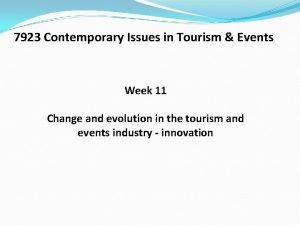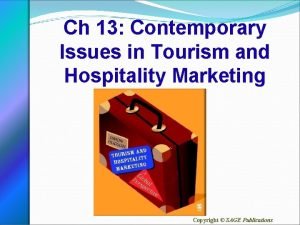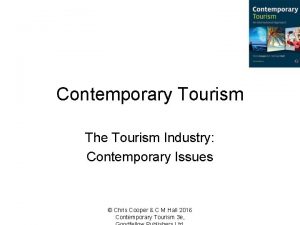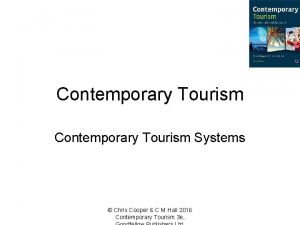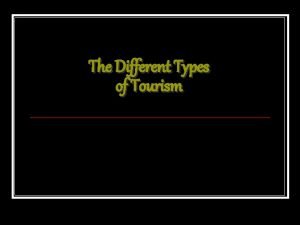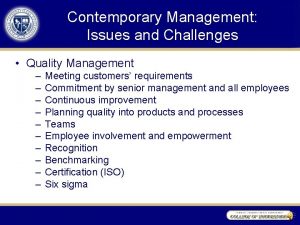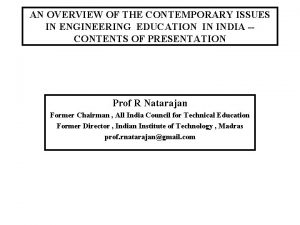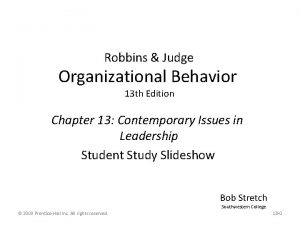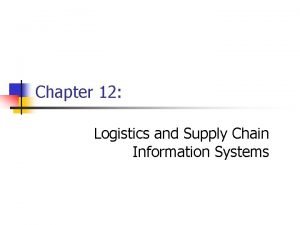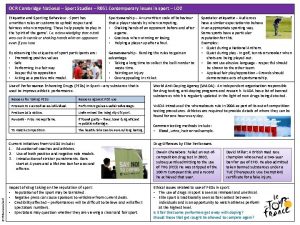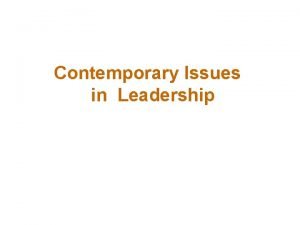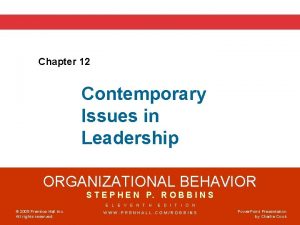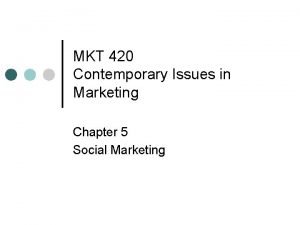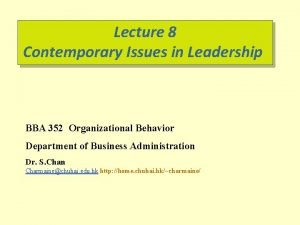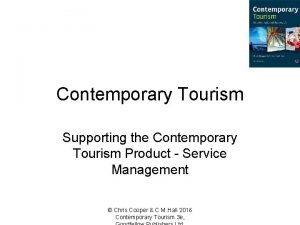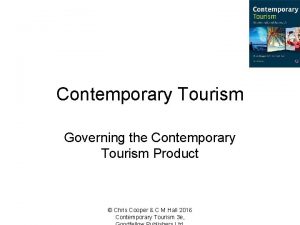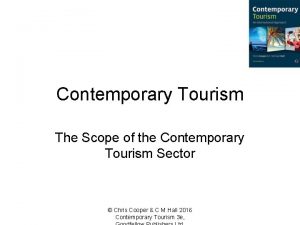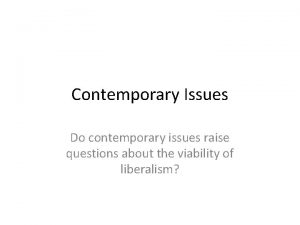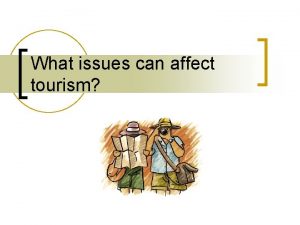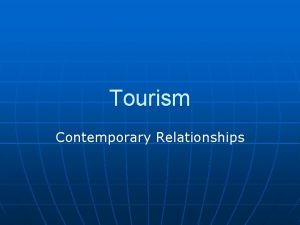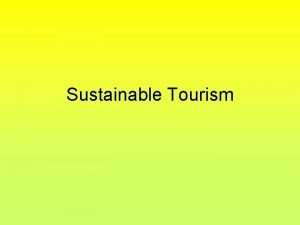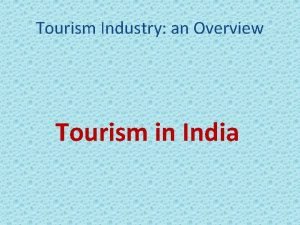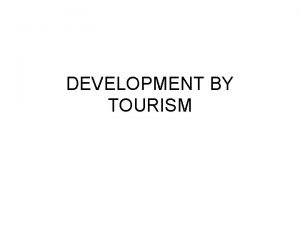7923 Contemporary Issues in Tourism Events Week 11


























- Slides: 26

7923 Contemporary Issues in Tourism & Events Week 11 Change and evolution in the tourism and events industry - innovation

So far we have been speaking about problems in tourism issues, and ways of managing these, but how can change be induced (=initiated by us), and be made to be a resource for the tourism and events industry? Now it’s time to talk about what Hall and Williams call “the centrality of innovation in tourism” Source: Hall & Williams 2008: 1

What is innovation? q “Innovation refers to the process of bring any new, problem solving idea into use. q Ideas for reorganising, cutting costs, putting in new budgetary systems, improving coordination or assembling products in teams are also innovations. q Innovation is the generation, acceptance and implementation of new ideas, processes, products or services… q Acceptance and implementation is central to this definition; it involves the capacity to change and adapt” Source: Kanter 1983, quoted in Hall & Williams 2008: 5


Tourism and change q We have been discussing change as an issue in tourism q “Tourism has always been subject to changes, reflecting shifts in tastes and preferences, technologies and politico-economic conditions. . . q And the history of tourism is littered by landmark innovations such as the emergence of new centres of pilgrimage, the introduction of rail travel and the popularization of credit cards” Source: Lofgen 1999, quoted in Hall & Williams 2008: 1

Social, economic, political and environmental changes driving innovation q. Changes in the organisation of work, leisure time and income q. Innovation from outside the tourism sector, especially in technology q. Tourism as a source of innovation, i. e. innovation from inside the sector q. Tourism as a transmitter of innovation


Tourism and innovation – tourism’s characteristics: � Production and consumption of tourism services is often simultaneous • Tourism is a set of linked services e. g. transport, hotels, attractions, retail, restaurants (recall the tourism system model) • Supply of tourism product can be highly time specific e. g. hotel bed, airline seat • Tourism services often closely linked to specific locations – also often clustered, using facilities with high sunk costs and operating in close proximity to other firms

Continued… q The experience tourists have in very closely related to their contact and interactions with tourism industry employees – and these contacts are highly visible to tourists, the public generally as well as competitors q Sustainability is increasingly important to the industry and its stakeholders q Tourism industry is very diverse – different sectors have different interests in and approaches to innovation


Tourism and innovation: characteristics of tourism firms q. Tourism firms vary in scale, ownership, position in the tourism system q. But some features do impact on innovation: Ø Very high tourism firm birth and death rates = can be a high risk operating environment Ø Strong difference between those competing on price and quality = different approaches to innovation Ø Time is often an issue; firms often have daily, weekly or seasonal peaks = capacity utilisation issues Ø Capital and entrepreneurship varies between firms, sectors



What drives innovation q. Competition – especially due to the ease of substituting tourism products q. Financial performance – innovative firms are more productive, better performers, more profitable? ? q. Demand driven – what do the punters want? q. Technology - what new systems are available? q. Firm level strategy & resources – does our business want / welcome or have the resources to pursue innovation? q. Individual entrepreneurship – what is the role of the individual? q. Government – policy and support (including $ and expertise)

Levels of innovation – how significant is an innovation? q. Some models: v Schumpeter 1934 Ø Ø Incremental – innovation within existing technologies and practices Radical – innovation outside these v Chan et al. 1988 Ø Incremental – small e. g. reducing waste in hotel kitchen Ø Distinctive – some adaptation of consumer behaviour e. g. advance purchase of discount airline tickets Ø Breakthrough – major new approach in consumer behaviour, technology or system organisation e. g. electronic ticketing

Some dimensions of innovation q q Space Time Scale Incremental vs. discontinuous q Product vs. process innovation q ‘Innovate or die’ – costs and benefits of innovation


Aim of innovation “The strategic goal of firms or places … should be to identify and implement innovations that add value to their operations” Hall & Williams 2008: 24 � �Is this always true? �Can you think of cases where it might not be appropriate?

What is required for innovation? q q Capital – resources to come up with, implement and sustain innovation Other resources e. g. organisational structure, culture and practices Entrepreneurship Knowledge


Innovation systems can operate at different levels: q International q National q State q Local / regional q Firms / sectoral level


Role of the state in innovation? q National q State q Regional / local q Note also the role of semi – state organisations e. g. business development agencies, state tourism organisations

One example: Regional systems Innovation is “an intrinsically territorial, localised phenomenon, which is highly dependent on resources which are location specific, linked to specific places and impossible to reproduce elsewhere” Source: Longhi & Keeble 2000, quoted in Hall& Williams 2008: 27

Regional features that can facilitate innovation q Proximity = encourages knowledge sharing, collective learning and development of trust q Localised social networks = support amongst firms; also the ‘gossip factor’ – informal contacts create opportunities to share (or steal) ideas q Cultural system can favour (or not) innovation q Local and regional agencies can support (or not) innovation q Existence of pools of skilled workers = contribute to networks and innovation

Other links q. Can local / regional factors assist individual firms at crucial stages of the Butler resort life cycle? q Can local / regional innovation systems influence cities’ ‘districts’ – cultural district, museum district etc. ?
 Contemporary issues in tourism
Contemporary issues in tourism Contemporary issues in hospitality industry
Contemporary issues in hospitality industry Contemporary tourism issues
Contemporary tourism issues Contemporary tourism definition
Contemporary tourism definition Contemporary tourism meaning
Contemporary tourism meaning Contemporary tourism
Contemporary tourism Week by week plans for documenting children's development
Week by week plans for documenting children's development Mass tourism vs alternative tourism
Mass tourism vs alternative tourism Contemporary management issues
Contemporary management issues Nursing definition
Nursing definition Contemporary issues in engineering
Contemporary issues in engineering Contemporary issues in planning
Contemporary issues in planning Contemporary
Contemporary Contemporary leadership issues
Contemporary leadership issues Contemporary issues in logistics
Contemporary issues in logistics Contemporary issues in marketing
Contemporary issues in marketing Contemporary issues in information systems
Contemporary issues in information systems Contemporary issues in marine insurance
Contemporary issues in marine insurance Contemporary issues in auditing
Contemporary issues in auditing Ocr sports studies
Ocr sports studies Contemporary leadership issues
Contemporary leadership issues Ro51 contemporary issues in sport
Ro51 contemporary issues in sport How does investment affect filipino entrepreneurs
How does investment affect filipino entrepreneurs Contemporary issues in hrm
Contemporary issues in hrm Contemporary issues in organizational behavior
Contemporary issues in organizational behavior Contemporary issues in marketing
Contemporary issues in marketing Contemporary issues in leadership
Contemporary issues in leadership
